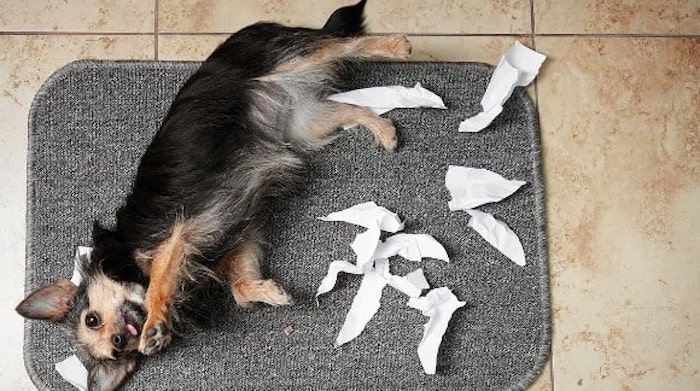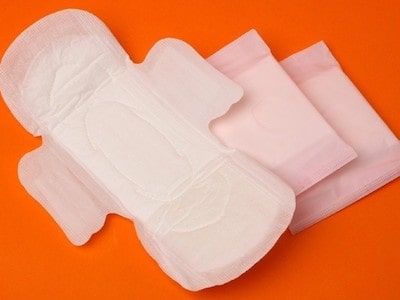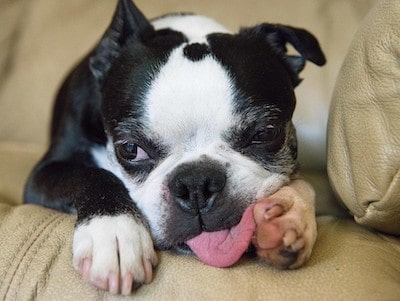Have you ever walked into a room only to find your beloved furry friend munching on your pads? It’s a perplexing and somewhat frustrating behavior that many dog owners experience. You might be wondering, “Why does my dog eat my pads?” It’s not a common behavior, but it can leave you scratching your head and searching for answers.

In this article, we’ll delve into the world of canine behavior to unravel the mystery behind why some dogs have a penchant for consuming pads. From exploring possible motivations to discussing ways to address this behavior, we’ll equip you with the knowledge you need to better understand and manage this curious habit.
So, let’s embark on a journey to uncover the reasons why our four-legged companions find pads so appetizing.
Common Reasons for Pad-Eating Behavior in Dogs
Dogs are curious and playful animals that like to explore their environment and use their mouth to interact with objects. They may also have different motivations and preferences for eating or chewing on certain things. Here are some of the possible reasons why your dog may eat your pads:
Curiosity and exploration
Dogs are naturally curious and explore everything through their noses and mouths. They can learn a lot about their environment and their owners by sniffing and tasting different objects.
Pads are especially attractive to dogs because they have a strong smell and taste of blood. Blood is a natural stimulus for dogs, as it indicates food or prey. Dogs may also be intrigued by the soft texture and tearing sound of pads.
Boredom and stress relief
Dogs need mental and physical stimulation to stay happy and healthy. When they get bored or stressed, they may find ways to entertain themselves or cope with their emotions. Some dogs may chew on things they find around the house, such as shoes, furniture, or pads.
Chewing can be a fun activity for dogs, as it releases endorphins that make them feel good. It can also be a way to relieve anxiety or frustration.

Hunger and nutritional deficiency
Dogs may also eat pads if they are hungry or have some sort of nutritional deficiency. Pads may provide some calories or nutrients that your dog is lacking in his diet.
For example, blood contains iron, which is essential for red blood cell production and oxygen transport. If your dog is anemic or has low iron levels, he may crave blood or other sources of iron.
Pica and compulsive disorder
Pica is a condition where dogs eat non-food items compulsively. It can be caused by medical or behavioral factors, such as diabetes, hormonal imbalance, thyroid disease, separation anxiety, stress, boredom, or obsessive-compulsive disorder (OCD).
OCD is a mental disorder where dogs perform repetitive behaviors that interfere with their normal functioning. Dogs with OCD may eat pads or other objects as a way to cope with their anxiety or obsession.
Risks and Dangers of Pad-Eating Behavior in Dogs
Eating pads can be very harmful and dangerous for your dog’s health and well-being. Pads are not designed to be ingested by animals and they can cause various problems and complications, such as:
- Intestinal blockage and perforation: Pads are made of synthetic materials that are not easily digestible by dogs. They can get stuck in your dog’s stomach or intestines and cause obstruction, inflammation, infection, bleeding, or rupture. This can lead to severe pain, vomiting, diarrhea, dehydration, shock, or even death.
- Infection and inflammation: Pads can harbor bacteria, fungi, viruses, or parasites that can infect your dog’s mouth, throat, stomach, or intestines. They can also cause allergic reactions or irritation in your dog’s skin, gums, tongue, or teeth. This can result in fever, swelling, redness, pus, bad breath, or loss of appetite.

- Toxicity and poisoning: Pads can contain chemicals, fragrances, dyes, or additives that can be toxic or poisonous to dogs. They can also absorb medications, supplements, or substances that you may have taken or used during your menstrual cycle. This can affect your dog’s nervous system, liver, kidneys, blood cells, or heart. This can cause seizures, tremors, weakness, confusion, jaundice, anemia, arrhythmia, or coma.
- Dental damage and oral injury: Pads can be hard or abrasive on your dog’s teeth and gums. They can cause dental fractures, cavities, erosion, or infection. They can also injure your dog’s mouth, lips, or tongue with sharp edges, threads, or hooks. This can result in bleeding, pain, or difficulty eating or drinking.
If you notice any of these symptoms or signs in your dog after eating or chewing on pads, you should seek immediate veterinary attention and treatment.
Tips to Prevent Your Dog From Eating Your Pads
The best way to prevent and eliminate pad-eating behavior in dogs is to address the underlying cause and provide alternative solutions. Here are some practical and effective ways to do so:
1) Keep pads out of reach and dispose of them properly: The most obvious and simple way to stop your dog from eating your pads is to keep them away from their access and sight. You should store your pads in a closed or locked cabinet, drawer, or container that your dog cannot open or reach.
You should also dispose of your used pads in a secure and sealed trash can or bag that your dog cannot access or tear. You may also want to use a menstrual cup, tampon, or reusable pad instead of a disposable pad, as they are less likely to attract your dog’s attention.
2) Provide alternative toys and treats for your dog: Another way to stop your dog from eating your pads is to give them something else to chew on or play with. You should provide your dog with a variety of toys, treats, or bones that are safe, durable, and appropriate for their size, age, and breed.
You should also rotate the toys and treats regularly to keep your dog interested and stimulated. You should also play with your dog more often and provide them with enough exercise and mental enrichment to prevent boredom and stress.
3) Ensure a balanced diet and adequate hydration for your dog: One more way to stop your dog from eating your pads is to make sure they are well-fed and hydrated. You should feed your dog with a high-quality, complete, and balanced diet that meets their nutritional needs and preferences.

You should also provide your dog with fresh, clean, and accessible water at all times. You should avoid giving your dog human food, table scraps, or snacks that are unhealthy, spicy, or toxic for them. You should also consult your veterinarian for any dietary supplements or adjustments that your dog may need.
4) Address any underlying medical or psychological issues in your dog: The final way to stop your dog from eating your pads is to treat any medical or psychological conditions that may be causing or contributing to this behavior. You should take your dog to the veterinarian for a regular check-up, vaccination, deworming, and spaying or neutering.
You should also follow the veterinarian’s advice and prescription for any medications, therapies, or surgeries that your dog may require. You should also provide your dog with a safe, comfortable, and stress-free environment and routine. You should also socialize and train your dog properly and positively to avoid anxiety, depression, or aggression.
5) Train your dog to obey commands and reward good behavior: The last way to stop your dog from eating your pads is to teach them to listen to you and behave well. You should train your dog to obey basic commands, such as “leave it”, “drop it”, “no”, or “come”.
You should also reward your dog with praise, treats, or affection when they follow your commands or ignore the pads. You should also avoid scolding, hitting, or punishing your dog when they eat or chew on the pads, as this may only make them more fearful, confused, or defiant.
FAQs
No, it is not considered a normal behavior for dogs to eat pads. While some dogs may exhibit this behavior occasionally, it is generally a cause for concern and should be addressed to prevent any potential health issues or complications.
Yes, it is advisable to consult a veterinarian if your dog repeatedly eats pads or exhibits any unusual behavior. They can evaluate your dog’s health, rule out any underlying medical conditions, and provide guidance on managing the behavior effectively.
Yes, training and positive reinforcement techniques can be beneficial in addressing this behavior. Teach your dog appropriate chewing habits, redirect their attention to approved chew toys, and reward them when they engage with those toys instead of pads. Consistency, patience, and positive reinforcement can contribute to modifying their behavior over time.
Yes, there are potential health risks involved when dogs consume pads. The materials used in pads, such as plastic or absorbent polymers, can be harmful if ingested. They may cause intestinal blockages or digestive issues. Additionally, if the pads have been soiled with chemicals or cleaning products, it can pose additional health risks.
Well, That’s a Wrap
While the sight of your dog eating your pads may initially leave you bewildered, understanding the reasons behind this behavior is the first step towards finding a solution.
We’ve explored various factors that may contribute to why dogs engage in pad consumption, including boredom, anxiety, teething, attention-seeking, nutritional deficiencies, and underlying medical issues.
By identifying the root cause, you can implement targeted strategies to discourage this behavior and redirect your dog’s chewing instincts towards more appropriate alternatives.
Remember, preventing your dog from eating pads requires a combination of proactive measures such as providing mental and physical stimulation, offering suitable chew toys, supervising your dog’s activities, and keeping pads out of their reach. Training your dog with positive reinforcement techniques can also play a vital role in modifying their behavior over time.

Ellis is a retired veterinary technician and full-time contributor at DogLovesBest. He likes writing about pet health care tips and reviews the products that are useful for fidos on a daily basis.
Ellis also guardians a Siberian husky, Nova, and a cat named Shilly. They all live happily with his wife Ammy, and both the dogs on a seaside apartment in Queens, NY.
